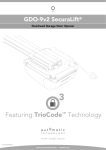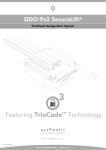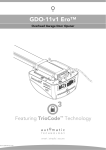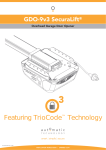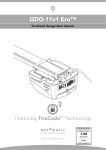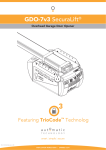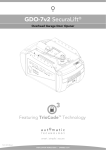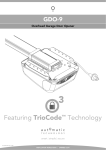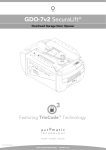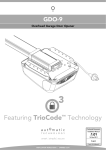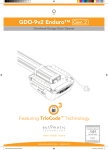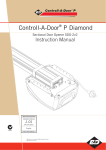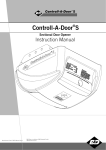Download Automatic Technology Australia GDO-2 SecuraLift Troubleshooting guide
Transcript
GDO-11v1 SecuraLift® Overhead Garage Door Opener Featuring TrioCode™ Technology Part # 13246 (Manual v1.02) WARNING: It is vital for the safety of persons to follow all instructions. Failure to comply with the installation instructions and the safety warnings may result in serious personal injury and/or property damage. Please save these instructions for future reference. Automatic Technology (Australia) Pty Ltd to the extent that such may be lawfully excluded hereby expressly disclaims all conditions or warranties, statutory or otherwise which may be implied by laws as conditions or warranties of purchase of an Automatic Technology (Australia) Pty Ltd Garage Door Opener. Automatic Technology (Australia) Pty Ltd hereby further expressly excludes all or any liability for any injury, damage, cost, expense or claim whatsoever suffered by any person as a result whether directly or indirectly from failure to install the Automatic Technology (Australia) Pty Ltd Garage Door Opener in accordance with these installation instructions. 2 GDO-11v1 SecuraLift® Owner Installation Instructions GDO-11v1 SecuraLift® Overhead Garage Door Opener Important Safety Instructions 4 Features 6 Operating Controls 8 Kit Contents 10 Installation 11 Knockdown C-Rail Assembly 11 C-Rail Attachment 13 Determine Door Type 14 Mounting - Track Type Door 15 Photo Electric Beam Installation 25 Mounting - Spring Loaded Door 16 Key switch 25 Mounting Door Bracket & Arms 17 Auxiliary output 25 18 Battery Back Up installation 26 SmartSolar™ Installation 27 Programming the Opener Setting Travel Limits - Control Panel 18 Setting Travel Limits - Transmitter Safety Obstruction Forces Safety Obstruction Force Test 19 Final Set Up 25 28 20 Pet Mode Door Height 28 20 Wall Mounted Transmitters 28 Re-Initialising 28 Default Settings & Specifications 29 Adjusting Safety Obstruction Forces 21 Coding Transmitters Accessories 22 Parameters 30 Door 22 Vacation Mode 22 Door Status Indicators 30 Auxiliary Out Put 22 Button functions 30 Pet Mode 23 Troubleshooting Guide 31 Courtesy Light 23 Maintenance Record 32 Remotely Coding Transmitters 24 Parts Listing 33 Erasing Transmitter Codes 24 Warranty 34 Owner Installation Instructions GDO-11v1 SecuraLift® 3 Important Safety Instructions WARNING: It is vital for the safety of persons to follow all instructions. Failure to comply with the following Safety Rules may result in serious personal injury and/or property damage. CAUTION: If your garage has no pedestrian entrance door, an emergency access device should be installed. This accessory allows manual operation of the garage door from outside in case of power failure. For ADDITIONAL ENTRAPMENT protection we STRONGLY recommend the fitting of a Photo Electric (P.E.) Beam. In most countries P.E. Beams are mandatory on all garage doors fitted with automatic openers. For a small additional outlay Automatic Technology recommends that Photo Electric Beams be installed with the automatic opener ensuring additional safety and peace of mind. DO NOT operate the opener unless the garage door is in full view and free from objects such as cars and children/people. Make sure that the door has finished moving before entering or leaving the garage. DO NOT operate the opener when children/persons are near the door. Children must be supervised at all times when the SecuraLift® is in use. Serious personal injury and/or property damage can result from failure to follow this warning. DO NOT allow children to operate the SecuraLift®. Serious personal injury and/or property damage can result from failure to follow this warning. Regularly check to make sure that the safety obstruction force is working correctly, and is tested and set as per page 20 of this manual. Failure to follow these instructions could result in serious personal injury and/or property damage. This test must be repeated at regular intervals and the necessary adjustments made as required. Doors requiring over 400N of force to move must have P.E. Beams installed. DO NOT disengage the door opener to manual operation with children/persons or any other objects including motor vehicles within the doorway. The door opener is not intended for use by young children or infirm persons without adequate supervision. Children should be supervised to ensure that they do not play with the remote transmitters or the opener. Keep hands and loose clothing clear of the door and door opener at all times. 4 GDO-11v1 SecuraLift® Owner Installation Instructions Important Safety Instructions The unit should be installed so that it is protected from the elements. It should not be exposed to water or rain. It is not to be immersed in water or sprayed directly by a hose or other device. The garage door must be well balanced. Sticking or binding doors must be repaired by a qualified garage door installer prior to installation of the opener. Frequently examine the installation, in particular cables, springs and mountings for signs of wear, damage or imbalance. DO NOT use if repair or adjustment is needed since a fault in the installation or an incorrectly balanced door may cause injury. DO NOT attempt to repair the door yourself as hardware is under extreme tension. Remove or disengage all garage door locks and mechanisms prior to installation of the opener. Connect the opener to a properly earthed general purpose 240V mains power outlet installed by a qualified electrical contractor. Disconnect the power cord from mains power before making any repairs or removing covers. Only experienced service personnel should remove covers from the opener. In order for the SecuraLift® to sense an object obstructing the door way, some force must be exerted on the object. As a result the object, door and/or person may suffer damage or injury. If the power supply cord is damaged, it must be replaced by an Automatic Technology service agent or suitably qualified person. Make sure that the door is fully open before driving in or out of the garage and fully closed before leaving the driveway. Make sure that remote controls are kept out of reach of children. Install the (optional) wall switch or (optional) wall mounted transmitter in a location where the garage door is visible, but out of the reach of children at a height of at least 1.8 meters from the floor. Owner Installation Instructions GDO-11v1 SecuraLift® 5 Features Thank you for purchasing the Automatic Technology GDO-11v1 SecuraLift® Overhead Garage Door Opener. Designed to suit sectional overhead and one piece tilt up doors, the components and materials used ensure this opener will provide years of smart, simple and secure operation. Listed below are some of the many features: Operation To open or close the door simply press a button on a TrioCode™ handheld transmitter, or optional wall switch for two seconds. During open and close cycles the door can be stopped by pressing the button again. The next actuation will move the door in reverse direction. TrioCode™ Code Hopping Technology Every time a TrioCode™ transmitter is used a new security code is randomly generated from over 4.29 billion possibilities. This greatly enhances the security of the system and makes “code grabbing” a thing of the past These transmitters also overcome interference issues by simultaneously sending a signal over three different frequencies. Even if two of the three signals are jammed, the system will still work. S-ALPS (Semi Automatic Limits Positioning System) The S-ALPS system does away with manual adjustment of the door’s limits position using mechanical parts, such as cams and microswitches. During installation the handheld transmitter can be programmed to set the limits positions. ISS (intelligent safety obstruction system) While the door is performing a close cycle, should it hit an obstacle or be restricted in some manner, it will automatically reverse. The amount of force the door should encounter before reversing is automatically adjusted by the doors control system during the initial installation of the automatic door opener. The door will also stop if restricted whilst opening. The Safety Obstruction Force should be checked monthly. Auto courtesy light The courtesy light comes on automatically for three minutes whenever the door is activated. The light can also be operated independently of the door by coding a dedicated button on a transmitter. 6 GDO-11v1 SecuraLift® Owner Installation Instructions SmartSolar™ and Battery Back Up Compatibility (optional) The opener can be fitted with a SmartSolar™ or Battery Back Up kit for operation in the event of a power outage, or where mains power access is not available. NOTE: If the door is the only entrance to the garage, and a battery back up kit is not fitted, a keyed cable release should be fitted external to the garage. Vacation mode A hand held transmitter can be programmed to lock and unlock all other transmitters that have been programmed into the openers’ memory. The vacation mode can be used when the door is left idle for long periods of time. Pet/Pedestrian mode The transmitter can be programmed to open the door to an adjustable partial height so that the family pet can enter and exit the garage at any time. You may also wish to open the door to a height suitable only for pedestrian access. Photo Electric (P.E.) Beam (optional) The opener has an input to connect a P.E. Beam for extra safety. Manual operation The opener is equipped with a unique manual disengaging device. If the power to the opener is disrupted the door can be put into manual mode by pulling down on the string handle on an angle towards the door. This allows for manual operation of the door. To re-engage the opener pull the string handle away from the door. Owner Installation Instructions GDO-11v1 SecuraLift® 7 Operating controls 01 Terminal Block. » » » » » » 02 CODING LED (red) light flashes when a code is being stored or when a transmitter button is pressed. 03 DOOR CODE BUTTON is used for storing or erasing transmitter buttons for door operation 04 DOOR STATUS LED (Yellow) 05 SET button (Orange) is used during the installation phase together with the Open and MINUS (-) buttons to set the door limit positions. The Set button is also used to re-initialize the Opener. 06 OPERATE button (Yellow) is used during installation to test the open, stop and close cycles for the 07 08 09 10 opener. The opener has to be initialised by the set button to make the OPERATE button operable. FORCE MARGIN SET Button: The obstruction force margin is set automatically during installation. The margin can be adjusted manually using the Force Margin Set button (White). Holding the Force Margin Set button and pressing PLUS (+) or MINUS (-) buttons will increase or decrease the amount of force. The Force Margin Set should only be used if environmental factors (wind, etc.) affect the door’s operation. OPEN LIMIT LED (green) the LED is very helpful during installation. It illuminates and flashes when the door is opening and remains steady on when the open limit position has been reached. PLUS (+) button (green) is used during installation to help set the open limit position. Pressing and holding this button will move the door in the open direction, releasing stops the door. NOTE: The safety obstruction detection is inoperable when the PLUS (+) button is used to move door. CLOSE LIMIT LED (red) the LED is very helpful during installation. It illuminates and flashes when the door is closing and remains steady on when the close limit position has been reached. 11 MINUS (-) button (red) is used during installation to help set the close limit position. Pressing and holding 12 DATUM ADJUST SCREW is used during limits set up to indicate the mid point of the door’s travel. 13 10A FUSE 14 8 24V PWR is used to power photo electric beam. PE (Input) for photo electric beam for safety. PE (0v) is used to supply 0 volts to photo electric beam. GND is used with OSC input or AUX out put O/S/C INPUT is used for the connection of a wired switch (momentary contact). This switch can then be used to open, stop or close the door. Install the wall switch in a location where the switch is out of reach of children and the garage door is visible. AUX (output) can be used to control alarm system . this button will move the door in the close direction. Movement stops when the button is released. NOTE: The safety obstruction detection is inoperable when the CLOSE button is used to move door.. PROG INPUT is used to connect the Automatic Technology Handheld Programmer “PG-3” for editing control and receiver functions, accessing diagnostic tools, and activating special features and operating modes. 15 JP1 SOLAR CONNECTOR onto this the shunt must be fitted for solar operation. 16 COURTESY LIGHT 15 watts 24 volts feston type globe is used for courtesy light GDO-11v1 SecuraLift® Owner Installation Instructions 12 fig 01 02 01 03 04 05 06 07 08 09 10 11 16 15 14 13 Owner Installation Instructions GDO-11v1 SecuraLift® 9 Kit contents GDO-11v1 Multipiece C Rail And Accessory 1 x GDO-11v1 SecuraLift® Ero drive unit (Fig. 02) 1 x TrioCode™ Transmitter pack (Fig. 02) (Pack includes 1x four button keyring transmitter and 1x two button keyring transmitter with batteries) 2 x Door attachment arms (Fig. 02) 1 x Accessory and hardware pack (Fig. 02) 1 x Chain (Fig. 02) 1 x C rail track pack (Fig. 02) (Pack includes three C rail sleeves and four C rail tracks) 1 x Shuttle assembly (Fig. 02) 1 x Installation Manual fig 02 OR Power Head And Accessory pack 1 x GDO-11v1 SecuraLift® Ero drive unit (Fig. 03) 1 x TrioCode™ Transmitter pack (Fig. 03) (Pack includes 1x four button keyring transmitter and 1x two button keyring transmitter with batteries) 2 x Door attachment arms (Fig. 03) 1 x Accessory and hardware pack (Fig. 03) 1 x Chain (Fig. 03) 1 x Shuttle assembly (Fig. 03) 1 x Installation Manual fig 03 PLUS Pre-Assembled Single Piece C-Rail Note: The chain or belt in the single piece rail has been tensioned by the factory. fig 04 10 IMPORTANT NOTE: If modification to the track length is required, adjustment must be made to the drive end side only. GDO-11v1 SecuraLift® Owner Installation Instructions Knockdown C-Rail Assembly Step 1 - Knockdown C-Rail Assembly Note: If your opener came with a one piece track, proceed to Assembly step 2, page 13. a. b. c. d. e. f. Tr ac k Place track pieces on flat surface for assembly. All the track sections are interchangeable. Slide sleeve onto the track section (Fig. 05). Connect track by sliding sleeve onto next track section. Tap track assembly on piece of wood until track sections are flush. Repeat with remaining track sections. Remove chain from package and lay chain out on floor (do not allow chain to twist). Loop the chain onto the pulley of tension chain assembly. Slide the tension chain assembly with chain into the track (Fig. 06). Slide shuttle assembly into (opener end) the track assembly, be sure to insert shuttle assembly with hole side toward the door as shown with arrow in (Fig. 07). Push the sprocket support into (opener end) of the track. Feed the chain through the shuttle assembly then through the sprocket support and loop around the sprocket then feed back through the sprocket support and shuttle assembly. Join to chain index with chain links ( supplied ) (Fig. 07). fig 05 Sle ev e Te ns ion as se mb ly Do or en d Op en er en d fig 06 Ch ain Idler pulley Shuttle with hole side toward the door fig 07 Ho le Owner Installation Instructions GDO-11v1 SecuraLift® 11 Knockdown C-Rail Assembly Do or en d Note: Use the 12 teeth sprocket with Gdo-11v1 opener. Op en er h. en d i. fig 08 12 te et hs pr oc ke t j. k. 9 teeth sprocket fig 09 Tension hex bolt Do or en d Op en er en d fig 10 Centre of the track 12 GDO-11v1 SecuraLift® Owner Installation Instructions Engage the shuttle with the chain index and move shuttle assembly to the centre of track. Make sure the chain is engaged into the sprocket and also wrapped around the centre of the pulley. Use a spring scale to measure required force to pull the shuttle, adjust 1/2” tension hex bolt (Fig. 09) to tension the chain. Move the shuttle back to the centre of the track to re-test the force with spring scale (Fig. 10). Continue to adjust adjust the tension hex bolt until a force of 8kg to 8.5 Kg is achieved. C-Rail Attachment Step 2 - Secure C-Rail to Drive Unit a. b. Shaft Locate and insert the shaft of drive unit into the CRail’s sprocket (Fig. 11). Fix the two track brackets with four screws supplied in accessory pack (Fig. 12). fig 11 Locate shaft into sprocket Mushroom Head Screw Taptite ‘S’ M4 x 8 Track bracket (x2) fig 12 Owner Installation Instructions GDO-11v1 SecuraLift® 13 Determine the Door Type Step 3 - Determine Door Type Determine which type of garage door you have as illustrated below. (Fig. 13 to 15). For a sectional (panel) door on tracks (Fig. 13) proceed with the installation from Step 4. Track fig 13 Door Sectional door with track For a one-piece door on tracks (Fig. 14) proceed with the installation from Step 4. fig 14 One piece door with track For a one-piece door without tracks (on springs) (Fig. 15) proceed with the installation from Step 8. Door fig 15 One piece door without track 14 GDO-11v1 SecuraLift® Owner Installation Instructions Mounting on a Track Type Door WARNING: The opener must be securely fastened to structural supports, otherwise opener failure may ensue causing serious personal injury and/or property damage. Level Level Track fig 16 Step 4 - Determine Bracket Position a. b. c. Open the door and find the highest point of travel of the top door panel. Using a level, transfer this height to the wall above the door (Fig. 16) and mark a line 60mm above it. Determine the centre point on the wall above and on top of the door. Draw two lines extending 21.5mm from each side of the centre point. (Fig. 17) Door Step 5 - Mounting the Wall Bracket a. b. c. Centre the bracket over the intersection of these two lines. Mark centres for at least two holes (Fig. 17). • Ensure this is into a solid mounting point Drill holes into the wall with an appropriate bit. Secure to the wall using: IF CONCRETE OR BRICK - 8mm (5/6”) loxins/dynabolts. IF TIMBER - wood screw #20 or similar (min. 50mm). 3 4 .5 1 52 21. fig 17 WARNING: Make sure concrete, brick wall or timber lintels are solid and sound so as to form a secure mounting platform. Drilled holes Step 6 - Attach the Rail to the Wall Bracket a. b. Attach the C-Rail assembly to the wall bracket with the 90mm long clevis pin and secure with the supplied snap pin (Fig. 18) Leave the powerhead in its packing box for protection during installation. fig 18 Step 7 - Secure the Powerhead to the Ceiling a. b. c. d. e. Raise the powerhead from the packing box and support it in the horizontal position with a step ladder or with a similar rigid object. Open the garage door. Rest the opener on the open door and use a scrap piece of wood to bring it to horizontal level. Line up the track perpendicular to the wall. Secure the perforated angle (not supplied) to the ceiling above where powerhead’s mounting holes will be once fully installed. A representative mounting is shown (Fig. 19) Connect the powerhead to the ceiling mounted perforated angle with M8x20mm screws and nuts. Strips should not extend more than 18mm below centre of powerhead mounting holes. Structural member fig 19 Go to Step 12 on page 17. Owner Installation Instructions GDO-11v1 SecuraLift® 15 Mounting on a non-Track Type Door WARNING: The opener must be securely fastened to structural supports, otherwise opener failure may ensue causing serious personal injury and/or property damage. Centre of Door Step 8 - Determine the Door’s Centre a. fig 20 b. Find the centre of the door and mark this location both above the door and on top of the door. Draw two lines 21.5mm either side of this (Fig. 20). Step 9 - Prepositioning the Opener a. b. c. Raise the door to open position. Rest the opener on the top edge of the door with end of the rail against the wall (Fig. 21). Support the powerhead level with the lowest point of the open door (Fig. 21). NOTE: Do not slide rail along the face of the door. Step 10 - Mounting the C-Rail a. fig 21 Step ladder b. c. d. e. C rail f. g. fig 22 Highest point of door travel Door Step ladder h. Close the door slowly. The rail will be elevated by the top edge of the door as it moves. Stop the door when it is at its highest point of travel. Allow 25mm additional height for clearance between the door and the track (Fig. 22). Support the Rail in this position and close the door The height determined in Step 10 (b) will be the height at which to mount the wall bracket. Centre the bracket along the line determined in Step 8 Using the bracket as a template, mark a minimum of two holes and drill with appropriate size bit. For a more secure fitting, the wall bracket can be anchored using more than two holes. Secure the bracket to the wall using: IF CONCRETE OR BRICK - 8mm (5/6”) loxins/dynabolts. IF TIMBER - wood screw #20 or similar (min. 50mm) Attach the bracket and C-Rail with supplied pins (Fig. 18). WARNING: Make sure concrete, brick wall or timber lintels are solid and sound so as to form a secure mounting platform. Step 11 - Secure the Powerhead to the Ceiling Drill hole at centre of track (recommended bolt size M6 or M8) a. b. fig 23 Ceiling Steel Rail Shuttle Assembly 16 GDO-11v1 SecuraLift® Owner Installation Instructions Secure the perforated angle (not supplied) to the ceiling above where powerhead’s mounting holes will be. See (Fig.19) for a representative mounting. Connect the powerhead to the ceiling mounted perforated angle with M8x20mm screws and nuts. Strips should not extend more than 18mm below centre of powerhead mounting holes (Fig. 19). Step 11.1 - Alternative Mounting Option The opener can be fastened to the roof by driving a bolt through the C-Rail into a structural timber support. The bolt head’s height must not exceed 6mm (Fig. 23). Mounting Door Bracket & Arms Step 12 - Mounting Door Bracket The door bracket comes in two parts. The bottom plate with two mounting holes is used on its own for one piece doors. For sectional doors, the top plate is placed over the bottom plate and is fixed with four (4) screws (Fig. 24). a. b. fig 24 Mount the door bracket, or bracket assembly, on the door’s centre line one-third down the top panel (Fig. 24) using M6 or equivalent screws (not supplied), STEEL DOORS ONLY: Bracket can be welded in place. NOTE: If in doubt about the door’s strength, reinforcement may be added to the door’s frame where necessary. Door damage may occur if the bracket is installed on a panel with insufficient strength. The opener’s warranty does not cover damage caused to the door and/or door panels. Straight arm connected to the shuttle fig 25 Step 13 - Attaching the Arms FOR SECTIONAL AND ONE PIECE DOORS WITH TRACK: the bent arm(connecting to a. Assemble the door) to the right side of the straight arm (connecting to the shuttle) with bolts and nuts supplied in the accessory pack (Fig. 25). Always use both bent and straight arms. b. Connect the assembled arm to the bracket and the disengaged trolley with clevis and snap pins. The angle “A” must be more than 10° (Fig. 26). WARNING: Connecting the bent arm other way around may damage the door. The straight arm should not protrude beyond heal of bent arm Bent arm onnected to the door Centre of the door 0 10 A fig 26 FOR ONE PIECE DOORS WITHOUT TRACK a. Assemble the bent and straight arms as shown in (Fig. 27) with bolts and nuts supplied in the accessory pack. Always use both the bent and straight arms. b. Connect the assembled arm to the bracket and the disengaged trolley with clevis and snap pins. c. If installing on a door with a bad wave action, lengthening the arm will assist in reducing this effect. IMPORTANT NOTE: Adjust the length of the cord so that its toggle is no more than 1.8m from the ground. fig 27 Owner Installation Instructions GDO-11v1 SecuraLift® 17 Setting Limits NOTE: If P.E. Beams are to be used they must be installed before setting the travel limits. Step 14.1 - Remove Controls Cover a. Swing open the controls cover to gain the access to the controls panel (Fig. 28) and swing back into its position when setup is completed. fig 28 Step 14.2 - Connect Power to the Powerhead Plug the power cord into a mains point and switch power on. The red CLOSE LIMIT LED will be flashing. WARNING: The safety obstruction detection system is inoperable while MINUS (-) and PLUS (+) drive buttons are being used and travel limits are not set. Step 14.3 - Set the Datum Position a. b. fig 29 Press and hold the MINUS (-) or PLUS (+) buttons to move the door to the halfway position. Ensure that the door, shuttle and chain index are engaged. Using a small screwdriver, turn the DATUM ADJUST screw until the STATUS LED comes on (Fig 29). » If the STATUS LED is already illuminated when the door is halfway up, turn the DATUM ADJUST screw until the light goes off, then turn back one notch to illuminate again. Step 14.4 - Set the Limits Positions a. b. c. Press and hold the MINUS (-) button until the door reaches the desired close limit position. Single presses will inch the door closed (Fig 30).. Press the LIMIT SET button to store the close position into memory (Fig. 30) Press and hold the PLUS (+) button until the door reaches the desired open limit position. Single presses will the inch the door open (Fig. 30). IMPORTANT WARNING: The door will automatically close, open and close again once Step 14.4(d) is performed. Ensure that no persons or objects are in the door’s path. a. d. Press the SET button to store the close position into memory (Fig. 30). The door will now automatically close and open to calculate the safety obstruction settings. After this, the opener can be operated with the OPERATE button. fig 30 Step 14.5 - Resetting the Door Limit Positions Limit positions can be deleted by the following steps: a. Press and hold the MINUS (-) button for six (6) seconds until you hear three beeps and the CLOSE LIMIT LED starts to flash. b. Release the CLOSE button. c. Repeat Steps 14.1 to 14.4 to set new travel limit positions.. 18 GDO-11v1 SecuraLift® Owner Installation Instructions Setting Limits: via Transmitter The GDO-11v1 has the unique ability to set travel limits using the transmitter, allowing the installer to move around the garage and door to better assess the desired close and open limit positions. Step 15.1 - Power Up and Set the Datum a. Follow Steps 14.1 to 14.3 as outlined overleaf. Observe all warnings! fig 31 Step 15.2 - Code a Transmitter for Limit Setting a. b. c. Press and hold the DOOR CODE button (Fig. 31). Press Button 1 on the transmitter for two seconds (Fig. 32). Release and pause for two seconds. Press the same button again on the transmitter for two seconds. Release the DOOR CODE button. Step 15.3 - Setting Limits via Transmitter a. b. c. d. e. Press and hold Button 4 on the transmitter to close the door. When the door is approx. 2 cm from the ground, release button 4. A brief press of Button 4 will allow you to “inch” the door closed. Keep doing this until the door reaches the desired close limit position. » If the door is closed too far, press Button 1 to “inch” the door towards open When happy with the close limit position, press Button 2 to store this in memory. Press Button 1 to open the door. When approx. 2 cm from the desired open position, release button 1. A brief press of Button 1 will allow you to “inch” the door open. Keep doing this until the door reaches the desired open limit position. » If the door is opened too far, press Button 4 to “inch” the door towards close. Button 1 (Inch Open) Button 4 (Inch Close) Button 2 (Set) fig 32 IMPORTANT WARNING: The door will automatically close, open and close again once Step 15.3 (f) is performed. Ensure that no persons or objects are in the door’s path. f. g. When happy with the open limit position, press Button 2 on the transmitter to store into memory. The door will now automatically close ,open and close to calculate the safety obstruction settings. After this, the opener can be operated with the OPERATE button. Step 15.4 - Resetting the Door Limit Positions Limit positions can be deleted by the following steps: a. Follow Steps 14.5 (a) and (b), as outlined overleaf. b. Repeat Steps 15.1 and 15.3 to set new travel limit positions. » There is no need to re-code the transmitter (Step 15.2) upon resetting travel limits. The transmitter will still be stored in memory. Owner Installation Instructions GDO-11v1 SecuraLift® 19 Safety Obstruction Force Test WARNING! Take care when testing or adjusting the Safety Obstruction Force. Excessive force may cause SERIOUS PERSONAL INJURY and/or PROPERTY DAMAGE WARNING! FOR ADDITIONAL ENTRAPMENT protection we STRONGLY recommend the fitting of a Photo Electric (P.E.) Beam. In most countries P.E. Beams are mandatory on all garage doors fitted with automatic openers. For a small additional outlay Automatic Technology recommends that Photo Electric Beams be installed with the automatic opener ensuring additional safety and peace of mind. fig 33 WARNING: Photo electric beams must be installed if the closing force at the bottom edge of the door exceeds 400N (40kgf) Step 16.1 - Testing Close Cycle a. b. fig 34 c. Press the OPERATE button to open the door (Fig. 33). Place a piece of timber approximately 40mm high on the floor directly under the door (Fig. 34). Press the OPERATE button to close door. The door should strike the object and start to re-open. Step 16.2 - Testing Open Cycle a. b. c. Press the OPERATE button to close the door (Fig. 33). Press again to open the door. When the door reaches the half open point, grab the bottom rail of the door firmly and the door should stop. If the door does not reverse readily when closing, or stop when opening, the force may be excessive and need adjusting, refer below. DANGER! If the door fails these tests, put the opener into manual mode, only operate the door by hand and call for service. 20 GDO-11v1 SecuraLift® Owner Installation Instructions Adjusting Safety Obstruction Forces Adjusting Safety Obstruction Force The Safety Obstruction Force is calculated automatically during setup. Adjusting this is normally only necessitated by environmental conditions such as windy or dusty areas, and areas with extreme temperature changes. WARNING: Photo electric beams must be installed if the closing force at the bottom edge of the door exceeds 400N (40kgf) fig 35 Step 17.1 - To Increase Force Pressure a. b. c. d. Hold down FORCE MARGIN SET button (Fig. 35) While holding the FORCE MARGIN SET button, press the PLUS (+) button. Each press increases the force margin (Fig. 35). The OPEN LIMIT LED will flash each time the PLUS (+) button is pressed to indicate a force increase » If the OPEN LIMIT LED on continuously when pressing the PLUS (+) button this indicates that the maximum setting has been reached. Test the force again as per Steps 16.1 and 16.2 Step 17.2 - To Decrease Force Pressure a. b. c. d. Hold down FORCE MARGIN SET button (Fig. 35) While holding the FORCE MARGIN SET button, press the MINUS (-) button. Each press decreases the force margin (Fig. 35). The CLOSE LIMIT LED will flash each time the MINUS (-) button is pressed to indicate a force decrease » If the CLOSE LIMIT LED on continuously when pressing the MINUS (-) button this indicates that the minimum setting has been reached. Test the force again as per Steps 16.1 and 16.2 fig 36 Step 17.3 - To Recall Factory Set Force a. b. While holding down the FORCE MARGIN SET button, press the SET button for two (2) seconds. (Fig. 36) Release both buttons. The default setting should now be recalled. Step 17.4 - To Recalculate Force Margins a. b. c. d. Press and hold the SET Button for two (2) seconds, the beeper will sound once (Fig. 37). The door will start to move and re-calculate force margins. The door can move between the open and close limit positions up to four (4) times (depending on the position of the door and the power up condition). A single beep will be heard once the process is complete. Test the force again as per Steps 16.1 and 16.2. fig 37 Owner Installation Instructions GDO-11v1 SecuraLift® 21 Coding Transmitters Step 18.1 - Code a Transmitter Button for Door Operation a. b. fig 38 c. d. Press and hold the DOOR CODE button (Fig. 38). Press one of the four buttons on the transmitter for two (2) seconds, pause for two (2) seconds, then press the same button again for two (2) seconds. Release the DOOR CODE BUTTON. Press the transmitter button to test. Step 18.2 - Code a Transmitter Button to Enable Vacation mode The opener can be programmed into a “Vacation Mode” where the opener will not respond to any transmitter except the button of the transmitter the one programmed for vacation mode. a. b. c. d. e. fig 39 Briefly press the DOOR CODE button once, then press it again and hold (will beep two times on second press (Fig. 39)). Press one of the four (4) buttons on the transmitter for two (2) seconds, pause for two (2) seconds, then press the same button again for two (2) seconds. Release DOOR CODE button. Press and hold the transmitter button for six (6) seconds to set Vacation Mode. the door code led will stay lit while vacation mode is active. To reset Vacation Mode press the same button for two seconds. Step 18.3 - Code a Transmitter Button to Enable AUX OUTPUT a. b. c. d. fig 40 22 GDO-11v1 SecuraLift® Owner Installation Instructions Briefly press the DOOR CODE button two (2) times, then press it again and hold (will beep three times on third press (Fig. 40)). Press one of the four buttons on the transmitter for two (2) seconds, pause for two (2) seconds, then press the same button again for two (2) second. Release the DOOR CODE button. Press the transmitter button to test. Coding Transmitters Step 18.4 - Code a Transmitter Button for Pet (Pedestrian) Mode a. b. c. d. e. Briefly press the DOOR CODE button three times, then press it again and hold (will beep four times on fourth press (Fig. 41)). Press one of the four buttons on the transmitter for two (2) seconds, pause for two (2) seconds, then press the same button again for two (2) seconds. Release the DOOR CODE button. Press the transmitter button to test. To change the default pet (pedestrian) door opening position, refer Step 2. fig 41 Step 18.5 - Coding a Transmitter Button to the Courtesy Light The transmitter can be programmed to operate the courtesy light on the opener independently of the door moving. a. Briefly press the DOOR CODE button four times, then press it again and hold (will beep five times on fifth press (Fig. 42)). b. Press one of the four buttons on the transmitter for two (2) seconds, pause for two (2) seconds, then press the same button again for two (2) seconds. c. Release the DOOR CODE button. d. Press the transmitter button to test the courtesy light. fig 42 Owner Installation Instructions GDO-11v1 SecuraLift® 23 Remote Coding & Deleting Transmitters Step 19 - Remotely Coding Transmitters Using this method transmitters can be coded without access to the opener’s control panel as long as a precoded transmitter is available. IMPORTANT NOTE: The door or courtesy light must activate when the steps below are performed. This indicates that the pre-coded transmitter is in range of the opener, and the correct button has been pressed. fig 43 a. b. c. d. e. Take any pre-coded transmitter. Press the button for the function to be duplicated and release. Using a small needle, press and hold firmly for two seconds through the Coding Hole (Fig. 43). WITHIN 10 SECONDS take the additional transmitter you wish to code. Decide which button that you want to activate the function to be duplicated (e.g. activate the door, or turn on the courtesy light) Hold the new transmitter’s button for two seconds, pause for two seconds, hold again for two seconds and then release. Wait for 10 seconds and then press the new transmitter’s button to test. Step 19.1 - Deleting a Stored Transmitter Code fig 44 a. b. c. d. Select the transmitter you want to delete. Press and hold the DOOR CODE BUTTON (Fig. 44). Press the transmitter button you would like to delete for two seconds, pause for two seconds, press again for two seconds and then release. Release the DOOR CODE BUTTON. The code should now be deleted. Confirm this by pressing the transmitter button - the function (e.g. door opening) should not respond. Step 19.2 - Deleting All Transmitter Codes a. b. c. fig 45 24 d. GDO-11v1 SecuraLift® Owner Installation Instructions Turn off power to the opener. While switched off, press and hold the DOOR CODE BUTTON (Fig. 45). Turn on power to the opener while holding this button. The OPEN LIMIT, CLOSE LIMIT and DOOR STATUS LEDs will illuminate for about five seconds. These LED’s will turn off and the CODING LED will illuminate. Release the DOOR CODE BUTTON. All stored codes will now be deleted. Confirm this pressing buttons on any previously coded transmitters the opener should not respond. P.E. Beams Step 20 - Fitting the P.E. Beams (optional) b. c. WARNING: When using P.E. Beams, the doorway must be clear of all obstructions and persons at all times. The location of the beams and manner in which it is installed might not give safety protection at all times. Check to make sure that the height of the beam and type used give maximum protection possible. Receiver Transmitter Model PE-2 RED RED RED RESISTOR = 2K2 0.25 WATT + - + - fig 46 BLACK BLACK BLACK BLACK YELLOW RED RED RED YELLOW PWR PE PE(0V ) GND OSC AUX OUT Affix the P.E. Beams in a strategic location within the doorway. We recommend 150mm above the floor level and as close as possible to the door opening, inside the garage. Connect the wires from the P.E.Beams wiring harness to terminal block (Fig. 46). The wiring diagram is for Model PE-2 (Order Code 90214). Make sure that you are using the correct resistor i.e. 2k2 ohms (Red Red Red gold) and connecting to number 2 (two) and 4 (four) terminal on the PE-2 receiver. Make sure to align the beams correctly. Follow the manual supplied with the P.E. Beams. GOLD a. WARNING: Install the P.E.Beams as per diagram in (Fig. 46). Tampering with P.E.Beams could result in serious personal injury and/or property damage and will void the warranty. Step 21 - key switch connection fig 47 Gdo-11v1 Has The Input To Connect Bell Switch Or Key Switch To Open Or Close The Door. Connect The Key/bell Switch As Per Diagram (Fig. 47). 30V PWR PE PE (0V) GND OSC AUX OUT Step 22 - Auxiliary out put The auxiliary output can be used to control alarm or another garage door opener. A valid transmission from the pre-coded transmitter will cause the auxiliary out put to pulse for approximately 1 (one) second. The maximum DC voltage must not exceed 35 volts DC. Maximum current must not exceed 80 ma.(Fig. 48). External device Alarm, Door opener etc. PWR PE PE(0V ) GND OSC AUX OUT Owner Installation Instructions GDO-11v1 SecuraLift® fig 48 25 Battery Back Up Installation fig 49 Step 23.1 - Connect the Battery Back Up Kit a. b. c. d. e. f. g. h. Disconnect power to the opener. Swing open the light diffuser and controls cover. Remove screws marked “S” above in fig and lift up the main cover. (Fig 49). Feed the SBY-3 charger harness through the grommet on the metal plate and connect to SBY-3 as shown in wiring diagram. Mount the brackets RA (item no 9) to battery pack with item 7 and 8 Secure the battery pack to gdo-11 with 2 screws item no 5. Feed the SBY-3 battery harness (item no 3 ) through the grommet on the metal chassis and connect to SBY-3 as per diagram. Mount the pcb support (item no 10) with two screws ( item no 5). Secure the SBY-3 charger board on to pcb support with 3 screws (item no 6). Feed charger harness from SBY-3 to the control board and plug into the 4 pin connector marked “SBY-3” onto the control board. i j Connect battery harnesses item 3 and 4 together (Fig 49). Reconnect power. Step 23.2 - Testing Battery Back Up a. b. Press either the OPERATE button or transmitter to test the opener. Whilst door is in motion disconnect mains power the door should continue to operate as normal. NOTE: Wait for the door to complete its travel. c. d. Press the OPERATE button or transmitter to activate the door. Whilst door is in motion re-connect power. The door should complete the cycle as normal. Step 23.3 - Troubleshooting WARNING: After Step 23.1 (i) the opener may become active (even when power is off). This is a result of a residual charge in the batteries. 26 GDO-11v1 SecuraLift® Owner Installation Instructions If door stops or moves very slowly under battery power, the batteries may be weak or have no charge. Connect mains power and allow the batteries to charge. This may take 24 - 48 hours to reach maximum charge capacity. SmartSolar™ Installation WARNING: Do not connect batteries until Step 24.3 Step 24.1 - Mount the Charger Board a. b. c. d. e. f. g. Disconnect power to the opener. Swing open the light diffuser and controls cover. Remove screws marked “S” above in fig and lift up the main cover. (Fig 50). Remove the transformer and mains power cable. Mount the pcb support with two screws .Secure the SBY-3 charger board on to pcb support with 3 screws. (Fig. 51). Plug the solar charger Board’s three wire harness (red/yellow/black) into the control board’s “SBY-3” connector on the control board. Plug the Charger Board’s white one wire harness into the control board’s “24vac in” connector. Plug the solar shunt (supplied) onto the control board’s “JP1” solar connector. S S Fig 50 IMPORTANT WARNING: Do not connect battery or solar panel polarity incorrectly - this will result in serious damage to components. Fig 51 Step 24.2 - Connect the Solar Panel a. b. c. Mount the solar panel as outlined in the SmartSolar™ Installation Manual. Feed the Solar Panel’s cable through black grommet located on the top of the metal plate. Connect the red wire to the Charger Board’s “SOLAR+” connector, and the black wire to the “–SOLAR” connector (Fig. 52). WARNING: During Step 24.3 the opener will become active. Black Yellow Red e Whit f. Red (From Ba ttery) e. ttery) d. Fig 52 Black (From Ba c. Mount the Battery Box close to the opener. Feed the 2-core 18awg gauge cable (supplied) through the Battery Box’s grommet. Connect the red wire to the Battery Box’s “+” terminal, and the black wire to the “–” terminal (Fig. 53). Feed the other end of the battery cable through the drive unit’s black grommet located on the metal plate. Connect the red wire to the Charger Board’s “BAT+” connector, and the black wire to the “– BAT” connector (Fig. 52). Refit the light diffuser and main cover. Red (From Solar P anel) a. b. olar Panel) Black (From S Step 24.3 - Mount & Connect the Battery ire W ck ire a l B dW e R Fig 53 Step 24.4 - Re-setup and Test the Opener a. b. Setup travel limits and code transmitters as per the GDO-11v1 instruction manual. Press either the OPERATE button or use a transmitter to operate the opener. Owner Installation Instructions GDO-11v1 SecuraLift® 27 Final Set Up Step 25 - Setting the Pet Mode position The default Pet Mode height can be changed as follows: a. Make sure the door is closed, then press and hold the PLUS(+) button for six (6) seconds (Fig. 54), until you hear three beeps and the OPEN and CLOSE LEDs flash rapidly. b. Press the OPEN or CLOSE button to move the door to the desired pet mode open position. c. Press the SET button to record the new position. fig 54 When activated, Pet Mode drives the door to the preset position from either above or below. Pet Mode’s active status is indicated by both the OPEN and CLOSE LIMIT LEDs being illuminated. If a Pet Mode button is pressed while the door is moving the door will stop. If a Pet Mode button is pressed when the door is in the Pet position, then the door will close. Step 26 - Installing the Wall Mounted Transmitter (Optional) a. b. c. d. fig 55 Remove the faceplate from the transmitter. Affix the baseplate in a convenient wall location (Fig 55) that is the door is visible from this location. but out of the reach of children at a height of at least 1.8 meters from the floor. Replace the faceplate. To code the transmitter, see Steps 10.1 through 10.4 on page 19. Step 27 - Reset all Factory Defaults a. b. c. fig 56 28 GDO-11v1 SecuraLift® Owner Installation Instructions Turn power to opener off. Press and hold the SET Button (Fig 56). Turn power on while holding the SET button. Continue to hold until all LEDs are off. » This will not erase transmitter codes stored in memory. Default Settings & Specifications Factory default settings Default Step Maximum Maximum motor run time 60 Secs. - - Courtesy light time 3 Mins. 10 Sec in battery back up mode Obstruction force margin 0.5 Amp 0.1 2 Amp Technical specifications Power supply 230V - 240V AC 50Hz Transformer rating 72 VA Standby power 2.2 Watts Motor power 90 Watts Motor type 24V DC permanent magnet Shuttle travel distance in the C-Rail 3.1m approx (standard) Maximum shuttle travel distance in the C-Rail 4m (with extended C-Rail) Maximum door opening: (With 3160mm Standard track) 5500mm (12m2) 2150mm 80 kg Width: Height: Weight: Minimum Clearance (Bottom of C-Rail to highest point of door travel) 25mm Short term peak force 650N (65kg) Lift force 400N (40kg) Nominal force 150N (15kg) Receiver type Multi-frequency FM Receiver Receiver code storage capacity 8 x 4 button transmitter codes Transmitter frequency ~= to 433.92 MHz Coding type TrioCode™ Number of code combinations Over 4.29 billion random codes Code generation Non-linear encryption algorithm Transmitter battery CR 2032 Courtesy light Festoon style lamp 24 volts 15 watts Controller fuse 10A slow blow NOTE: Intermittent operations may occur in areas which experience very strong winds. The strong wind puts extra pressure on the door and tracks which may in turn trigger the safety obstruction detection system intermittently. P.E Beams should be fitted as added safety in case of entrapment. Owner Installation Instructions GDO-11v1 SecuraLift® 29 Parameters Door Status Indicators Door Opener State OPEN LED (Green) Open On Close Opening CLOSE LED (Red) Beeper On Flashing Closing Flashing Door travel stopped Flashing Door obstructed when opening Flashing Door obstructed when closing Flashing Flashing Opener overloaded Alternating flashes Alternating flashes Pet Mode Engaged On On Mains power interrupted Rapid flashes Beeps as door moves Button Functions 30 Buttons Function OPERATE Opens/Stops/Closes the door DOOR CODE Codes a transmitter button for operate function, Vacation function, Auxilary function, Pet mode and Light function FORCE MARGIN SET & OPEN Increases the obstruction force margin setting FORCE MARGIN SET & CLOSE Decreases the obstruction force margin setting FORCE MARGIN SET (then) SET Resets the factory default force margin settings CLOSE (for 6 secs.) Clears the door limits set positions. Limits then need to be reset PLUS(+) (for 6 secs.) Enters pet (pedestrian) position mode SET (then power on) & hold until all LEDs are off Deletes control parameters excluding transmitter storage memory DOOR CODE (then power on) & hold until all LEDs are off Deletes all transmitter storage memory SET & DOOR CODE (the power on) and hold until all LEDs are off Deletes all control parameters and transmitter storage memory. SET Re-initialises the Opener to re-calculate force margin GDO-11v1 SecuraLift® Owner Installation Instructions Troubleshooting guide Symptom Door will not operate Door starts to close but automatically reverses to open position Possible cause Remedy Mains power not switched on Switch on mains power Door is obstructed Remove obstruction Door is locked or motor jammed Unlock door or remove jam Door tracks/hardware damaged Door requires service/repair by qualified technician Adverse weather conditions (wind or cold) causing door to stiffen and become tight in the tracks Increase force margin setting. See Step 17 on page 21 Possible obstruction in the doorway Door operates from drive unit (operate) button but not from transmitter.* Transmitter code not stored in memory Flat battery *See note Remove obstruction Code transmitter into opener’s memory. Refer Step 18.1 on page 22 Replace battery Door will not close fully Door limits position need to be reset Reset limits positions. Refer Step 15.4 on page 19 Door will not open fully Door limits position need to be reset Reset limits positions. Refer Step 15.4 on page 19 Courtesy light not working Faulty light Replace lamp PE Beam click but door does not reverse open when PE Beam is obstructed during close cycle Wrong value of resistor is used 2k2 ohms resistor must be used on the receiver of PE Beam PE Beam or wiring faulty PE Beam not aligned correctly PE Beam is obstructed Remove obstruction See Step 20 on page 25 PLEASE NOTE: Some areas may be prone to excessive radio interference brought on by devices such as cordless telephones, wireless stereo headphones and baby monitors. It is possible that these devices could cause a degree of interference such as to greatly reduce the range of the transmitter. In such an instance please contact your ATA dealer for an alternative frequency replacement kit. As this is not a warrantable situation but an environmental issue charges may apply for the changeover. Owner Installation Instructions GDO-11v1 SecuraLift® 31 Maintenance Maintenance Yearly Whilst your opener does not require any periodic maintenance, the door that it is fitted to does. Your garage door is a large, heavy, moving object and should be tested regularly to ensure it is in good condition. A poorly maintained door could cause fatal or serious injuries or serious damage to property. Automatic Technology suggests you contact your installer to perform an annual door service. To ensure a long and trouble free life for your opener the following is recommended: Monthly • • Disengage the opener and manually operate the door: The door must be smooth to operate by hand. An operating force on the bottom rail should not exceed 150N (15kg) force. Each month check that the opener reverses when the door contacts a 40mm high object placed on the floor (AS3350). CAUTION: Frequently examine door, particularly cables, springs and mountings for signs of wear, damage or imbalance. Do not use if repair or adjustment is needed since a fault in the installation or an incorrectly balanced door may cause injury. (AS3350) Adjustments should only be carried out by experienced persons, as this function can be dangerous if not performed under strict safety procedures. WARNING! Failure to maintain your garage door may void the warranty on your garage door opener. • NOTE: If the door does not operate smoothly, call your installer. Service Record Record any maintenance in the following table to assist in any warranty service. Date 32 Service by Signature GDO-11v1 SecuraLift® Owner Installation Instructions Invoice No. Amount Parts Listing Owner Installation Instructions GDO-11v1 SecuraLift® 33 Warranty and Exclusion of Liability 1. This warranty is an addition to any non-excludable conditions or warranties that are implied into this contract by relevant statute, including the Trade Practices Act 1974 (Cwth). 2. Subject to all of the matters set out below, Automatic Technology Australia Pty Ltd (“ATA”) warrants: (a) overhead door opener drive units for twelve (12) months or 2500 cycles, whichever occurs first; and (b) all components and accessories for twelve (12) months, from the date of purchase (specified in the sales docket receipt) as free of any defects in material and workmanship. 3. This warranty applies only where the purchaser: (a) immediately notifies ATA or the retailer of the alleged defect; (b) returns the product to the retailer; and (c) presents the relevant sales docket and this warranty document to the retailer to confirm the date of purchase. 4. Except for this warranty, ATA gives no warranties of any kind whatsoever (whether express or implied), in relation to the product, and all warranties of whatsoever kind relating to the product are, to the extent permissible by statute, hereby excluded. 5. To the extent permissible by statute, ATA disclaims any liability of whatsoever nature in respect of any claim or demand for loss or damage which arises out of: (a) accidental damage to or normal wear and tear to the product or to the product’s components; (b) any cost relating to damage resulting from wear and tear; (c) blown fuses, loss or damage caused by electrical surges, power surges or power spikes; (d) loss or damage due to theft, fire, flood, rain, water, lightning, storms or any other acts of God; (e) maximum continuous operating time exceeding one (1) minute in ten (10); (f) maximum operating force exceeding *15kg (150N) when moving the door manually to the open or closed position; (g) door surface area and/or weight exceeding 12m2 and 80kg respectively; (h) door not in safe and correct working order and condition; (i) evidence of unauthorised repairs; (j) any cost relating to damage caused by misuse, negligence or failure to maintain the equipment in a proper working order as per clauses (d) through (h); (k) installation, adjustment or use which is not in accordance with the instructions set out in installation instruction manual (l) attempted or complete modification or repairs to the product carried out by a person who is not authorised or has not been trained by ATA to carry out such modification or repairs; (m) faulty or unsuitable wiring of structure to which the product is fixed or connected; (n) radio (including citizen band transmission) or any electrical interference; (o) damage caused by insects; (p) loss or damage to any property whatsoever or any loss or expense whatsoever resulting or arising there from or any consequential loss; (q) any cost or expense arising due to manufacturer recall of any product; (r) any cost or expense due to negligence of the approved service provider; (s) installation of a residential garage door opener in a commercial or industrial situation or a non-single residential dwelling. 6. ATA’s liability under this warranty is limited, at ATA’s absolute option, to replacing or repairing the product which ATA, in its unfettered opinion, considers to be defective either in material and/or workmanship or to credit the dealer with the price at which the product was purchased by the dealer. 7. This warranty does not extend to cover labour for installation. 8. This warranty is limited to Return-to-Base (RTB) repair and does not cover labour for on-site attendance. 9. This warranty is void if the Product is not returned to the manufacturer in original or suitably secure packaging. 10. This warranty is only applicable for repairs to the product carried out within Australia. 11. This warranty does not cover consumable items including globes, batteries and fuses. 12. This warranty is not transferable. 13. Where the Product is retailed by any person other than ATA, except for the warranty set out above, such person has no authority from ATA to give any warranty or guarantee on ATA’s behalf in addition to the warranty set out above. NOTES: 1. One (1) cycle = one (1) open and one (1) close action of the door or gate. 2. This warranty is to be read in conjunction with the owner’s copy of the installation instruction manual. 3 *The door should be balanced in such a way that the user manually is able to open or close the door without using force not greater than 150N (15kg ) although a greater force may be required for the start of the movement. 34 GDO-11v1 SecuraLift® Owner Installation Instructions Owner Installation Instructions GDO-11v1 SecuraLift® 35 © August 2008 Automatic Technology (Australia) Pty Ltd. All rights reserved. TrioCode™ and SecuraLift ® are trademarks of Automatic Technology (Australia) Pty Ltd. No part of this document may be reproduced without prior permission. In an ongoing commitment to product quality we reserve the right to change specification without notice. E&OE. Automatic Technololgy (Australia) Pty Ltd ABN 11 007 125 368 6-8 Fiveways Boulevard Keysborough, Victoria, 3173, Australia P 1300 133 944 +61 2 9722 5666 (International Enquiries Only) E [email protected] www.ata-aust.com.au GARAGE DOOR OPENERS | GATE OPENERS | REMOTE CONTROL ACCESS SOLUTIONS




































